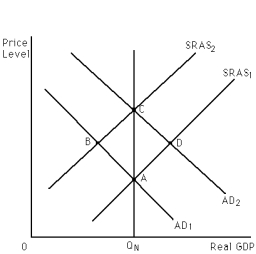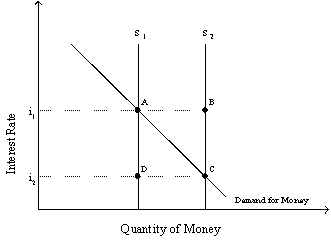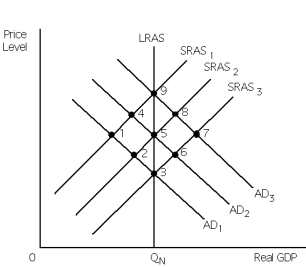A) interest rate falls.
B) interest rate rises.
C) supply of money rises.
D) none of the above,since the quantity demanded of money is unrelated to the interest rate
F) C) and D)
Correct Answer

verified
Correct Answer
verified
Multiple Choice
The economy is in the horizontal portion of the AS curve,there is a liquidity trap,and investment spending is sensitive to changes in the interest rate.According to the Keynesian transmission mechanism,if the money supply increases the interest rate __________,investment spending __________,the AD curve __________ and the price level __________.
A) falls;rises;shifts to the right;rises
B) falls;rises;shifts to the right;remains unchanged
C) does not change;does not change;does not change;does not change
D) does not change;shifts to the left;does not change;rises
E) rises;falls;left;falls
G) A) and C)
Correct Answer

verified
Correct Answer
verified
Multiple Choice
If the interest rate increases,the opportunity cost of holding money __________,and the quantity demanded of money __________.
A) does not change;does not change
B) increases;also increases
C) decreases;increases
D) increases;decreases
E) decreases;also decreases
G) C) and D)
Correct Answer

verified
Correct Answer
verified
Multiple Choice
According to the monetarist transmission mechanism,a decrease in the money supply __________ aggregate demand.
A) directly increases
B) indirectly increases
C) directly decreases
D) indirectly decreases
E) equals the increase in
G) C) and D)
Correct Answer

verified
Correct Answer
verified
Multiple Choice
Activists believe that
A) there is sufficient flexibility in wages and prices to allow the economy to equilibrate at full-employment Real GDP in a reasonable period of time.
B) discretionary fiscal policies do not work.
C) discretionary monetary policies do not work.
D) fine-tuning to smooth out the business cycle is feasible.
F) B) and C)
Correct Answer

verified
Correct Answer
verified
Multiple Choice
According to Keynesians,__________ monetary policy will not remove the economy from a(an) __________ gap if __________.
A) contractionary;recessionary;investment is interest-insensitive
B) expansionary;recessionary;the economy is in the liquidity trap
C) expansionary;inflationary;investment is interest-insensitive
D) contractionary;inflationary;the economy has been in the inflationary gap for more than one year
E) none of the above
G) B) and E)
Correct Answer

verified
B
Correct Answer
verified
Multiple Choice
Exhibit 15-1  -Refer to Exhibit 15-l.A Keynesian monetary policy to eliminate a recessionary gap can be portrayed as a move between points
-Refer to Exhibit 15-l.A Keynesian monetary policy to eliminate a recessionary gap can be portrayed as a move between points
A) A and B.
B) B and C.
C) C and D.
D) D and A.
F) None of the above
Correct Answer

verified
Correct Answer
verified
Multiple Choice
Assume the Keynesian transmission mechanism is operational and the economy is currently operating in the horizontal portion of the AS curve.If the money supply increases and the demand for money curve is downward sloping and investment is interest ____________,then Real GDP will ___________________.
A) sensitive;rise
B) insensitive;remain unchanged
C) sensitive;remain unchanged
D) insensitive;rise
E) a and b
G) C) and D)
Correct Answer

verified
E
Correct Answer
verified
Multiple Choice
Which scenario best explains the Keynesian transmission mechanism when the money supply increases while the money market is in a liquidity trap?
A) The interest rate and investment are not affected;there is no shift in the AD curve.
B) The interest rate falls,investment rises,total expenditures rise,and the AD curve shifts rightward.
C) The interest rate falls,investment falls instead of rising,and the AD curve ends up shifting leftward.
D) The interest rate falls,but investment does not respond;there is no change in total expenditures and no shift in the AD curve.
F) C) and D)
Correct Answer

verified
Correct Answer
verified
Multiple Choice
Exhibit 15-1  -Refer to Exhibit 15-l.A Keynesian would say that natural market forces work so slowly in a recessionary gap in taking the economy between point __________ that an activist monetary policy is called for.
-Refer to Exhibit 15-l.A Keynesian would say that natural market forces work so slowly in a recessionary gap in taking the economy between point __________ that an activist monetary policy is called for.
A) B and point D
B) B and point C
C) C and point B
D) B and point A
F) A) and C)
Correct Answer

verified
Correct Answer
verified
Multiple Choice
The liquidity trap is the
A) vertical portion of the demand curve for money.
B) horizontal portion of the demand curve for money.
C) vertical portion of the supply curve of money.
D) horizontal portion of the supply curve of money.
E) vertical portion of the demand curve for investment.
G) A) and B)
Correct Answer

verified
Correct Answer
verified
Multiple Choice
Exhibit 15-2  -Refer to Exhibit 15-2.A(n) __________ in the money supply from S1 to S2 would have a tendency to __________ the opportunity cost of holding money.
-Refer to Exhibit 15-2.A(n) __________ in the money supply from S1 to S2 would have a tendency to __________ the opportunity cost of holding money.
A) increase;raise
B) increase;lower
C) decrease;raise
D) decrease;lower
F) B) and C)
Correct Answer

verified
Correct Answer
verified
Multiple Choice
From the Patterns of Sustainable Specialization and Trade (PSST) perspective,expansionary monetary and fiscal policies that are designed to boost aggregate demand
A) will not work if the money market is in disequilibrium,and may end up making the economy worse.
B) will not work unless alternative sources of energy are employed.
C) may not work if buyers and sellers are out of sync with one another,and may end up making the economy worse.
D) are always successful in pushing the economy to full-employment.
F) A) and D)
Correct Answer

verified
Correct Answer
verified
Multiple Choice
Economists who favor activist monetary policy often argue that
A) during the mid-1970s,money supply growth rates were nearly constant and still the economy went through a recession.
B) during the mid-1970s,activist monetary policy was applied and the economy was healthy and stable.
C) activist monetary policy is inflexible and this is one of its virtues;the money supply doesn't change every year in response to political considerations.
D) activist monetary policy is likely to be destabilizing most of the time,but still it is the better way to proceed.
F) A) and C)
Correct Answer

verified
Correct Answer
verified
Multiple Choice
If you believe the economy is self-regulating,you are more likely to be a(an) __________ than a(an) __________.
A) nonactivist;activist
B) Keynesian;monetarist
C) activist;nonactivist
D) advocate of fiscal policy;advocate of monetary policy
E) b and d
G) None of the above
Correct Answer

verified
Correct Answer
verified
Multiple Choice
The Taylor Rule specifies that the federal funds rate target should be equal to
A) 0.5 ( inflation rate) + 1.5 (GDP gap) + 1
B) 1.5 (inflation rate) + 0.5 (GDP gap) + 1.
C) interest rate - expected inflation rate.
D) equilibrium federal funds rate + inflation rate +1
F) A) and B)
Correct Answer

verified
Correct Answer
verified
Multiple Choice
The money supply decreased and the AD curve shifted to the left.This is consistent with the
A) Keynesian transmission mechanism when there is neither a liquidity trap nor interest-insensitive investment.
B) monetarist transmission mechanism.
C) Keynesian transmission mechanism when there is a liquidity trap.
D) Keynesian transmission mechanism with interest-insensitive investment.
E) a and b
G) B) and E)
Correct Answer

verified
E
Correct Answer
verified
Multiple Choice
Under conditions of a liquidity trap and interest-insensitive investment,Keynesians would be most likely to propose __________ policy to eliminate a recessionary gap.
A) expansionary fiscal
B) contractionary fiscal
C) expansionary monetary
D) contractionary monetary
F) B) and D)
Correct Answer

verified
Correct Answer
verified
Multiple Choice
Exhibit 15-3  -Refer to Exhibit 15-3.The economy is currently at point 5.If contractionary monetary policy is implemented,and prices are flexible,the economy will likely move to point ______ in the short run.
-Refer to Exhibit 15-3.The economy is currently at point 5.If contractionary monetary policy is implemented,and prices are flexible,the economy will likely move to point ______ in the short run.
A) 1
B) 3
C) 2
D) 4
E) none of the above
G) C) and E)
Correct Answer

verified
Correct Answer
verified
Multiple Choice
In the Keynesian transmission mechanism,if the money market is in the liquidity trap,an increase in the money supply will
A) cause total expenditures and aggregate demand to increase.
B) cause total expenditures and aggregate demand to decrease.
C) have no impact on total expenditures and aggregate demand.
D) cause total expenditures to increase and aggregate demand to decrease.
E) cause total expenditures to decrease and aggregate demand to increase.
G) A) and D)
Correct Answer

verified
Correct Answer
verified
Showing 1 - 20 of 176
Related Exams